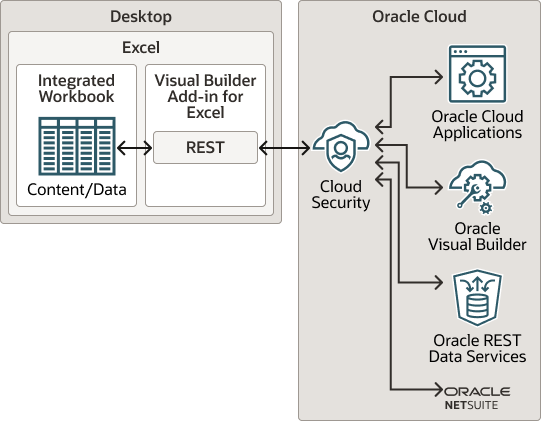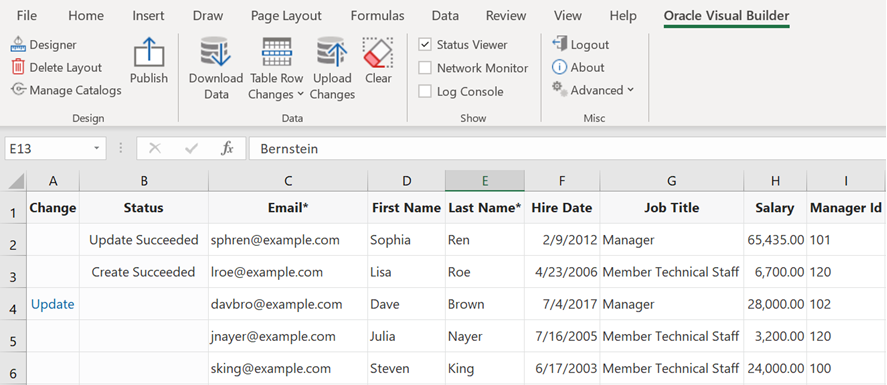2 Introduction to Oracle Visual Builder Add-in for Excel
Oracle Visual Builder Add-in for Excel integrates Excel spreadsheets with REST services to retrieve, analyze, and edit business data from the service. You download your data to an Excel spreadsheet, work with it, then upload your changes back to the service.

Key Concepts, Components, and Terms
Before you use Oracle Visual Builder Add-in for Excel, it helps to become familiar with these key concepts, components, and terms.
| Term | Description |
|---|---|
| Integrated workbook | An Excel workbook configured to work with one or more business objects. |
| Service | A web service that provides access to application data. The add-in works with REST services. Throughout this book, REST service is implied whenever "service" is mentioned. "Web resources" is another equivalent term. See Representational state transfer for an overview of REST. |
| OpenAPI | The OpenAPI Specification defines a standard, language-agnostic interface to RESTful APIs which allows both humans and computers to discover and understand the capabilities of the service without access to source code, documentation, or through network traffic inspection. Refer to the OpenAPI specification here: https://swagger.io/specification/. |
| Business object | A resource - like a purchase order or invoice - that has fields to hold your application's data. A business object includes a collection path, an item path, a set of fields, and other properties. |
| Business object catalog | A set of one or more business objects with a common host and base path. |
| Path | A path identifies the specific resource in the host that a web client requests access to, for example: /fscmRestApi/resources/11.13.18.05/draftPurchaseOrders.
|
| Collection path | A service path (endpoint) that can be used to fetch multiple rows of data from the business object and/or to perform operations on the collection. |
| Item path | A service path (endpoint) that can be used to fetch, or operate on, a single row from the business object. |
| Metadata path | A service path (endpoint) that can be used to fetch the service metadata for the business object. |
| Layout | A way to display a business object in an Excel worksheet. Each worksheet supports one of two layouts: Table or Form-over-Table. Layouts are created by workbook developers and are visible to business users in published workbooks. |
REST Frameworks
For simplicity, the add-in guides use these short forms for the REST frameworks the add-in supports.
| REST Framework | Short Form | More Information |
|---|---|---|
| NetSuite SuiteTalk REST web services | NetSuite | About NetSuite Services |
| Oracle ADF REST Resource | ADF REST | Oracle ADF REST Resource |
| Oracle REST Data Services | ORDS | Oracle REST Data Services |
| Visual Builder Business Objects | VBBO | Visual Builder Business Objects |
Installation
To install the latest version of Oracle Visual Builder Add-in for Excel, download and run the installer.
You can find the latest version of the installer at the Downloads page on Oracle.com.
For more information, refer to Install Oracle Visual Builder Add-in for Excel.
Next Steps
After you install the add-in, a new Oracle Visual Builder ribbon tab appears in Microsoft Excel. As a workbook developer, you use the options in this ribbon tab to configure a worksheet to integrate with a service and download data to a data table that you create in the worksheet. Once the data table is created and populated with data, you can review, modify, and create data, then upload your changes to the service.
This image shows a worksheet that is integrated with an REST service that manages employees: 
Description of the illustration excel-docexample.png
- In the Oracle Visual Builder tab, click Designer.
- Provide the URL of a service metadata document that complies with the OpenAPI specification.
- Pick a business object.
- Download data.
Review subsequent sections in this guide to understand available layout types and other add-in capabilities. For Excel specifications and limits, see Microsoft documentation.